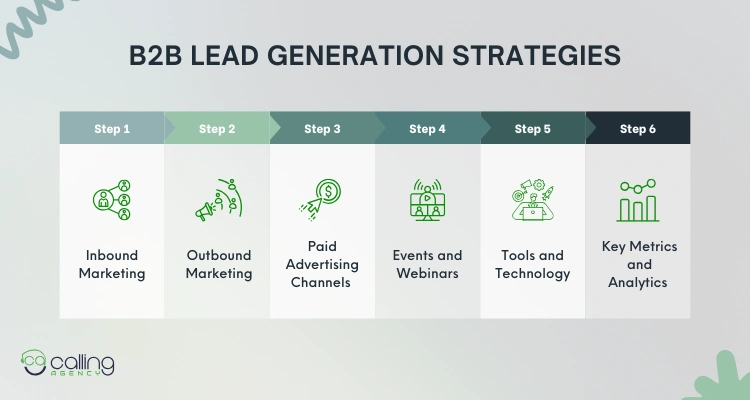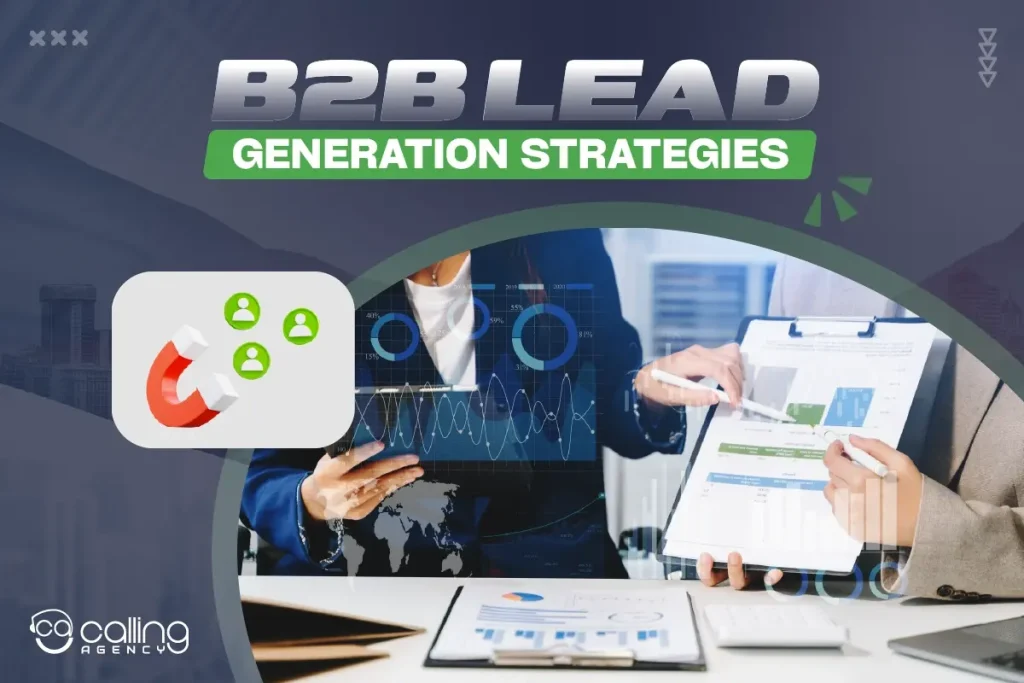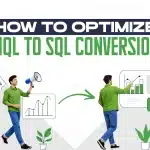Generating high-quality leads is the backbone of B2B marketing. Modern buyers are more informed, selective, and expect personalized experiences before making decisions. That’s why businesses need effective, data-driven lead generation strategies that not only attract prospects but also nurture them into loyal customers.
Today, we will show you proven B2B lead generation strategies to increase conversions, strengthen relationships, and drive sustainable business growth.
What Is B2B Lead Generation and Why It Matters
B2B lead generation is the process of identifying and attracting potential business customers who are interested in a company’s products or services. It is simply the process of businesses trying to find other businesses to sell their products and services to.
Lead generation is a very important activity for B2B companies because it directly impacts sales, revenue, and business growth. By effectively generating leads, businesses can understand their market better, build a strong sales pipeline, build relationships with potential clients, increase conversion rates, improve brand awareness, and ultimately generate more revenue.
How to Generate B2B Leads Using Inbound Marketing
Inbound marketing for B2B lead generation focuses on attracting potential customers through valuable content and experiences, rather than interrupting them with traditional advertising. It involves creating helpful content that is relevant to your target audience, optimizing it for search engines, and using social media to connect with them where they are active. Here’s how inbound marketing is used to generate B2B leads:

SEO Strategies to Capture High-Intent B2B Traffic
To capture high-intent B2B leads through SEO, focus on in-depth keyword research, creating targeted content that addresses specific customer needs, and optimizing for user experience and technical SEO. 23.31% of marketers say their website (or SEO) generated the most ROI for their businesses in 2024, closely followed by social media shopping tools, email marketing, and paid social media content.
- Keyword Research: Target keywords that indicate a strong purchase intent related to specific products, services, or solutions. Then try to understand what users are trying to achieve with their searches and tailor content to meet their specific needs.
- Content Strategy: Develop blog posts, white papers, case studies, and guides targeting client pain points. Align content with the buyer’s journey and showcase authority through insights, data-driven analysis, and success stories to build trust and credibility.
- Optimization: Optimize your website for a better customer experience by making sure it loads quickly, making it user-friendly on mobile, and ensuring easy navigation so users can quickly find the information they need.
- Authority and Trust: Boost authority with high-quality backlinks from reputable sites, publishing expert content on industry platforms. Use customer testimonials, reviews, and case studies as social proof to build trust, credibility, and improve search rankings while reaching a broader audience.
- Measuring and Refining: Track SEO metrics like traffic, bounce rate, time on site, and conversions to measure strategy effectiveness. Monitor organic search performance, identify high-performing keywords and content, and regularly refine strategies based on data insights to drive leads and sales.
Content Marketing and Webinars That Convert Visitors
Content marketing and webinars are powerful tools that can improve lead generation and conversions. Webinars offer a platform for live, engaging content that builds brand authority and deeper audience connections. Here’s how they can be used:
- Brand Authority: Webinars featuring guest experts establish your brand as a thought leader and trusted resource in your industry and attract interested attendees. Live interaction, Q&A sessions, and polls create a more engaging experience than static content formats.
- Repurposing Content: Webinar recordings can be transformed into blog posts, social media snippets, podcasts, etc., to maximize their value. Repurposed webinar content can be optimized for search engines and drive organic traffic to your website.
- Targeted Content: Analyze your audience and look for their needs and demands. Then create your webinar topics to match your audience’s interests and pain points, offering valuable insights and actionable takeaways.
- Compelling CTAs: Include compelling call-to-actions in your content. This encourages attendees to take the next step, whether it’s signing up for a free trial, downloading a resource, or scheduling a consultation. Personalized CTAs convert 202% better than basic ones.
- Follow-Up and Tracking: Nurture leads with personalized emails, relevant content, and offers based on their webinar engagement. Track key metrics like registration numbers, attendance rates, lead generation, and conversion rates to optimize your future webinars.
Automate and Score Leads to Maximize Efficiency
Automating and scoring leads maximizes efficiency by streamlining the process of identifying, qualifying, and nurturing potential customers, ultimately boosting conversion rates and sales productivity. Here’s how it helps:
- Lead Identification and Qualification: Automation speeds up lead generation by capturing leads from multiple sources, scoring them based on behavior and demographics, and enabling personalized outreach. This helps you focus on high-potential leads, deliver targeted content, increase engagement, and improve conversion rates efficiently.
- Lead Nurturing: Automated email sequences and personalized content can guide leads through the sales funnel, keeping them engaged and moving them closer to a purchase. Automation can also trigger specific actions based on their behavior, ensuring timely and relevant communication.
- Increasing Productivity: Automation increases productivity by handling repetitive tasks like data entry, follow-ups, and lead tracking. Sales teams can focus on high-scoring leads, build stronger relationships, and close deals faster, ultimately speeding up the sales process and shortening conversion timelines.
- Dara-Driven Insights: Automation tools provide valuable insights into lead behavior, campaign performance, and conversion rates, helping businesses refine their strategies. They can also analyze historical data to predict which leads are most likely to convert, allowing for proactive targeting and resource allocation.
- Improving ROI: By automating lead generation tasks, you can reduce the cost associated with acquiring new leads. It makes lead management and personalized outreach result in higher conversion rates more efficient, leading to increased revenue.
Outbound Lead Generation Tactics That Drive Qualified Leads
Outbound lead generation tactics involve proactively reaching out to potential customers who haven’t previously engaged with your business. Effective outbound strategies include personalized cold emails, targeted LinkedIn outreach, and strategic cold calling. The key outbound lead generation tactics to drive qualified leads are described below:
Cold Email Best Practices for B2B Lead Conversion
To maximize your cold email conversion rates, focus on personalization, value-driven content, clear calls to action, and strategic follow-ups. 34.49% of companies leverage email marketing, an effective lead generation channel, in their overall marketing strategy.
- Targeted Audience and Research: Identify your ideal customer profile and design your messaging according to their specific needs and challenges. Before sending an email, thoroughly research the recipient’s company. Also, positioning your product or service as a solution by addressing their pain points.
- Compelling Content: At first, create engaging subject lines that make recipients open your mail. Focus on providing value in a concise and easy-to-understand manner and personalize messages by using the recipient’s name and company, and create the content to match their specific needs and challenges.
- Clear CTA and Follow-up: A clear call-to-action is important to encourage your recipient to take the next step. And instead of relying on just one email, follow up with prospects who haven’t responded to show your commitment and increase your chances of engagement. Personalized CTAs convert 202% better than basic ones.
- A/B Testing: Experiment with different subject lines and email copy to see what resonates best with your audience and optimize for higher open and response rates. Also, monitor your email campaigns regularly to see what’s working and what’s not, and make adjustments accordingly for continuous improvement.
- Timing and Compliance: Choose the right time to send your emails when prospects are the most active. And make sure you are following all relevant email and outreach laws and regulations.
How to Use Cold Calling for B2B Sales Prospecting
To effectively use cold calling for B2B sales prospecting, focus on thorough research, a strong opening, clear communication, and building rapport. Here’s how you can use cold calling:
- Researching Prospects: Before making a call, research and learn as much as you can about the target company and the individual you’re contacting. LinkedIn, company websites, and industry news can provide valuable insights into their needs and challenges.
- Value Proposition: Learn about your product or service well and know how it can benefit your customers. Be prepared to clearly articulate to the prospect how your product or service solves specific problems for your target audience.
- Talk Track: Have a flexible script or outline to guide your conversation, but be ready to adapt to the prospect’s responses. Also, consider the best time of day and day of the week for cold calling based on your target audience’s industry and work habits.
- Listen and Engage: Be confident and professional, and actively listen to the prospect’s responses and adjust your message accordingly. Ask questions that encourage the prospect to share their challenges and needs, and shift the focus from your product to the prospect’s pain points and how you can help them.
- Follow Up: Record details of the call, including prospect information, conversation points, and follow-up actions. Then follow up with prospects who show interest, but don’t be afraid to move on if they are not a good fit or are not interested.
LinkedIn Outreach for High-Value B2B Connections
LinkedIn outreach for high-value B2B connections involves a combination of targeted engagement, personalized messaging, and strategic content sharing to build meaningful relationships and generate qualified leads. Here’s how it works:
- Targeting and Segmentation: Use LinkedIn Sales Navigator to precisely target decision-makers based on industry, job title, company size, and other relevant criteria. Define the characteristics of your ideal customer to focus your outreach efforts and group prospects based on shared characteristics to adjust your messaging and content.
- Personalized Connection: Before sending a connection request, review their profile and find common ground or mention specific accomplishments or interests. Create a short, human-like message that highlights mutual connections, shared interests, or relevant content, and explain how you can help them or offer valuable insights.
- Engagement: Engage with their content and share your own valuable content, industry insights, or helpful resources to establish yourself as a knowledgeable resource. Share relevant articles or insights that provide value and spark conversation.
- Follow Up: If a prospect interacts with your content, follow up with a personalized message or offer. You can use LinkedIn’s InMail feature to reach out to prospects who are not yet connected, but use it sparingly and personalize the message. Continue to engage with prospects, provide value, and build a genuine connection over time.
- Profile Optimization: Ensure your profile is up-to-date, highlights your expertise, and includes a professional headshot. Add recommendations, endorsements, and showcase your skills and experience.
Paid Advertising Channels That Attract B2B Buyers
For B2B businesses, effective paid advertising channels include LinkedIn, Google Ads, PPC, and paid social media like Facebook, Twitter, etc. Here’s how paid advertisement channels attract B2B buyers:
PPC Campaigns That Target Decision-Makers
Focus on platforms like LinkedIn and Google Ads with strong account-based marketing (ABM) and intent-based targeting strategies to target decision-makers effectively in PPC campaigns. Here’s how it’s done:
- Platform Selection: For B2B targeting, offering granular control over job titles, industries, and company sizes, go for LinkedIn ads, and use Google Ads for search ads. Microsoft advertising can be a valuable addition to your strategy for reaching a different segment of the market than Google.
- Account-Based Marketing: ABM integration can be done using LinkedIn’s Matched Audiences or Google’s Customer Match to target specific companies and decision-makers. Use dynamic remarketing ads and insights from your CRM to personalize ad copy and design for your target accounts based on user behavior.
- Intent-based Targeting: To target based on intent, focus on keywords like buy, request, etc., that indicate a strong purchase intent. Also, use negative keywords to exclude irrelevant search queries and avoid wasted ad spend.
- Ad Copy and Landing Pages: Focus on the benefits your product or service offers and how it solves specific pain points, and include a strong call-to-action. Ensure landing pages match the intent of your ads to provide a good user experience.
- Follow-up and Optimization: Follow up with users who have shown interest in your product or service. Regularly analyze your campaign performance and make adjustments to improve results continuously.
Social Media Ads to Generate Business Leads
Social media ads can effectively generate business leads by reaching a targeted audience and directing them to a desired action, such as filling out a form or visiting a website. 69.56% of marketers use Facebook in their marketing strategy, followed by Instagram (60.31%) and YouTube (58.77%).
- Targeted Ads: Social media platforms offer advanced targeting options to ensure your ads reach the most relevant audience. Use lead ads, like Facebook Lead Ads, to collect contact information directly within the platform. This helps maximize your ad spend, improve the quality of leads, and increase conversion rates.
- High-Quality Content: Create visually appealing and engaging content with images, videos, and stories that are relevant to your target audience and align with your brand. This is more important in social media marketing as it grabs attention, especially when people are scrolling.
- Profile Optimization and Engagement: Ensure your social media profiles are complete, professional, and include links to relevant landing pages. This is important to show your target audience that you are a trusted source and encourage them to engage with you further, building long-term relationships.
- Specific Platforms: Different platforms may have different audiences. LinkedIn is ideal for B2B due to its professional network and advanced targeting options. 53.95% of marketers say that Facebook is the social media channel that generated the most ROI, followed by Instagram (42.77%).
- Track and Analyze: Monitor the performance of your campaigns, track key metrics, and make adjustments to optimize your strategy. Look for the social media platforms that bring the highest amount of leads to adjust your marketing strategies accordingly.
Using Events and Webinars as B2B Lead Magnets
B2B webinars and events can be highly effective lead magnets by attracting potential customers, engaging them with valuable content, and capturing their information for future follow-up. Here’s how they help:
Promote Registration Through Email, Social Media, and PPC
You can effectively promote B2B registrations across email, social media, and PPC advertising by focusing on targeted content, compelling offers, and strategic execution. This involves understanding your audience, creating personalized messaging, and using the strengths of each channel and platform to drive conversions.
Capture and Nurture Leads Post-Event
To effectively capture and nurture leads after an event or webinar, focus on gathering contact information during registration, segmenting attendees based on engagement, and providing targeted follow-up content. This includes sending personalized emails, offering relevant resources, and using a CRM to automate and track the process. Indeed, companies that successfully leverage lead nurturing generate 50% more sales-ready leads.
Essential Tools and Technology for B2B Lead Generation
Important tools and technology for effective B2B lead generation include CRMs, email automation tools, lead scoring software, and data providers. The essential tools and technology for B2B lead generation are described below:
CRMs for Lead Management and Sales Alignment
CRMs are essential for B2B companies to manage leads and align sales efforts. The key CRM features for B2B include lead management, sales automation, and reporting. Popular B2B CRMs include Salesforce Sales Cloud, HubSpot CRM, Zoho CRM, Pipedrive, and Microsoft Dynamics 365. These platforms help businesses organize leads, track interactions, and automate tasks for increasing sales and improving customer relationships.
Email Automation Tools for Scalable Outreach
B2B email outreach tools offer features like email personalization, automation, and deliverability tracking. Popular tools include HubSpot, GetResponse, Smartlead, and Lemlist. These tools can help you manage large campaigns, personalize emails for better engagement, and ensure emails reach the intended recipients. They also offer scalable email marketing automation with features like A/B testing, autoresponders, and detailed analytics.
Lead Scoring Software to Prioritize Prospects
Lead scoring software helps B2B businesses prioritize potential customers by assigning numerical values, known as scores, to leads based on their characteristics and buying behavior. Some popular software offering effective lead scoring are HubSpot, Marketo, Salesforce Pardot, Clearbit, etc. For instance, if a business uses lead scoring and finds that leads with a score above 80 are more likely to convert, it indicates the effectiveness of the lead generation strategy.
Data Providers for List Building and Enrichment
Several data providers specialize in B2B list building and enrichment, offering various features and data types to support sales and marketing efforts. These providers typically offer firmographic, technographic, and contact data, along with intent signals and other insights. Some key B2B data providers include ZoomInfo, Cognism, Clearbit, Lush, UpLead, etc.
Key Metrics and Analytics for Measuring B2B Lead Generation Success
To measure B2B lead generation success, focus on key metrics like Lead Volume, Lead Quality, Cost Per Lead (CPL), and conversion rates at various stages (MQLs to SQLs to Opportunities). Tracking these, along with Customer Acquisition Cost (CAC) and Customer Lifetime Value (CLTV), provides a comprehensive view of campaign performance and ROI. Here’s how you can measure your B2B lead generation success:
Monitor Funnel Performance and ROI
Monitor funnel performance and ROI by analyzing lead quality, conversion rates, deal velocity, and revenue across each stage of the funnel. You can identify shortcomings to optimize touchpoints accordingly and align marketing and sales efforts. Regular performance tracking ensures strategies remain data-driven, maximize efficiency, and generate measurable business growth while improving the overall buyer journey.
Analyze Lead Quality and Conversion Rates
Analyzing lead quality and conversion rates is necessary for optimizing your marketing and sales efforts. It involves assessing the characteristics of leads, measuring how effectively they progress through the sales funnel, and identifying areas for improvement to increase revenue. By consistently doing this, you can gain valuable insights into what works, identify areas for improvement, and ultimately drive more revenue.
Optimize Based on Reporting and Insights
You can optimize your strategies using reporting and insights by analyzing performance metrics, lead sources, and conversion data. Identify high-performing channels, refine targeting, and adjust your messaging according to the reports. Continuous data-driven improvements ensure better lead quality, higher ROI, and stronger sales alignment.
How to Continuously Improve and Scale B2B Lead Generation
Improvement is a continuous process that requires you to test and refine messaging, targeting, and channels, and scale winning tactics across departments continuously. While you are busy with other important activities of your business, getting professional B2B lead generation services can help you achieve this goal. Here’s how it’s done:
Test and Refine Messaging, Targeting, and Channels
Continuously test and refine messaging, targeting, and channels to identify what resonates most with your prospects. A/B test your campaigns, analyze engagement, and optimize strategies to improve lead quality, increase conversions, and maximize return on investment.
Scale Winning Tactics across Departments
To effectively scale successful B2B lead generation tactics across departments, focus on standardizing processes, cross-departmental collaboration, and using data-driven insights. This includes implementing shared tools, creating clear communication channels, and regularly reviewing performance metrics to identify areas for improvement and ensure consistent execution.
Conclusion
Effective B2B lead generation attracts the right prospects, builds trust, and guides them toward long-term partnerships. By combining data-driven insights, personalized outreach, and continuous optimization, businesses can create a scalable system that consistently delivers high-quality leads. Implementing these strategies will not only increase conversions but also strengthen your brand’s authority and drive sustainable growth.
Need more advice for you to grow your B2B business? We provide active professional guidelines for your purpose, so never hesitate to reach out!





